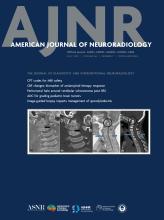Case of the Month
Section Editor: Nicholas Stence, MD
Children's Hospital Colorado, Aurora, CO
April 2016
Next Case of the Month coming May 3 …
Atypical Meningioma, WHO Grade II, Invasive
- Background—General:
- Meningiomas are the most common extra-axial neoplasms and account for 15% of all intracranial tumors.
- Three grades exist based on the WHO criteria. Most are WHO Grade I; approximately 6% are WHO Grade II; and rare are WHO Grade III neoplasms (malignant with metastatic potential).
- Many variants of meningioma have been described in the literature.
- Atypical meningiomas fall under WHO Grade II tumors, accounting for 5–15% of all meningiomas.
- The incidence of reporting of these tumors has increased since revision to the WHO classification in 2007.
- Background—Pediatric/Infantile Meningioma:
- Pediatric meningiomas are rare and account for fewer than 5% of all pediatric intracranial neoplasms.
- Infantile meningiomas (< 12 months old) are even rarer, with fewer than 30 reported cases.
- Pediatric patients usually present with increased intracranial pressure and seizures.
- Intraventricular and skull base locations are more common in children relative to adults.
- Risk factors for pediatric meningiomas include neurofibromatosis II and prior radiation therapy.
- There is a higher incidence of atypical or aggressive subtypes in pediatric patients.
- Key Diagnostic Imaging Features:
- Brain CT shows an intra-axial or extra-axial mass with bone destruction. The tumor is usually hyperdense with peritumoral edema but minimal or no calcification.
- Brain MRI shows indistinct tumor margins with infiltrating tumor interdigitating with normal brain parenchyma on T1 weighted imaging. T2WI and FLAIR images show peritumoral edema. Postcontrast imaging typically shows an enhancing tumor that involves both the skull and scalp. MRV may show dural sinus invasion.
- Conventional angiography shows an intense vascular stain that appears early and persists late. The venous phase may show dural sinus invasion.
- Typical imaging findings of meningioma do not exclude atypical variants. Histology is needed for definitive diagnosis.
- Histology:
- 4–19 mitotic figures/10 HPF OR
- Brain Invasion OR
- Three of the following histologic features:
- Increased cellularity
- Small cells that have high nuclear to cytoplasmic ratio
- Large nucleoli
- Loss of lobular architecture
- Geographic areas of necrosis
- Differential Diagnosis:
- Typical meningioma: Usually noninvasive, but histology is needed for definitive diagnosis.
- Dural metastasis: Extracranial neoplasm is usually known (eg, neuroblastoma)
- Lymphoma: Often lytic bone lesion with epidural and extracranial components
- Ewing sarcoma: Often osseous laminated periosteal reaction
- Treatment:
- Gross total or subtotal resection is usually performed, followed by adjunctive radiation therapy. Stereotactic radiosurgery also plays a role.
- Currently, there are no effective chemotherapeutic agents available.
- Atypical meningiomas are uncommon and have poorer prognosis when compared to benign meningiomas. Atypical meningiomas have a recurrence rate of 28%. The 5-year survival rate is estimated to be 86%, while the 5-year recurrence-free survival is estimated to be 48%.











